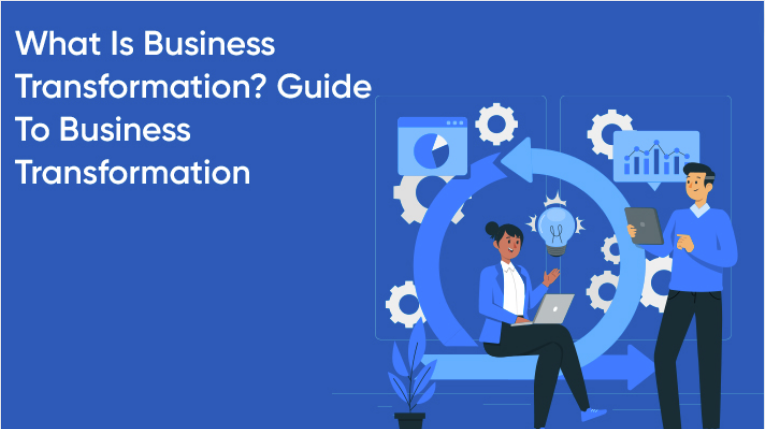Business transformation is a strategic and holistic approach that organizations undertake to fundamentally change how they operate, deliver value, and stay competitive in a rapidly evolving business landscape. It encompasses a wide range of initiatives, including process optimization, digitalization, cultural change, and organizational restructuring. In this guide, we'll explore what business transformation is, why it's essential, and provide a comprehensive roadmap for navigating this complex journey.
What is Business Transformation?
Business transformation is not just a buzzword; it's a critical response to the ever-changing business environment. It involves reimagining and reinventing various aspects of an organization to drive sustainable growth, enhance operational efficiency, and stay ahead of the competition. Unlike smaller, incremental changes, business transformation aims to create a more profound and lasting impact on an organization's structure, processes, culture, and technology.
Why is Business Transformation Essential?
1. Adapting to Change: The business landscape is continually evolving due to technological advancements, market dynamics, and customer expectations. Organizations must transform to remain relevant and resilient.
2. Competitive Advantage: Companies that successfully transform gain a competitive edge by responding swiftly to market shifts, reducing costs, and delivering superior products or services.
3. Innovation: Business transformation fosters innovation by encouraging new ideas, experimentation, and a culture of continuous improvement.
4. Enhanced Customer Experience: Transformation often leads to improved customer experiences, which can result in higher customer loyalty and increased revenue.
5. Operational Efficiency: Streamlining processes and leveraging technology can boost operational efficiency, reducing waste and costs.
6. Talent Attraction and Retention: A forward-thinking, transformative organization tends to attract and retain top talent who are excited about working for an innovative company.
Guide to Business Transformation
Embarking on a business transformation journey requires careful planning, execution, and continuous monitoring. Here's a comprehensive guide to help you navigate the process effectively:
1. Define Your Vision and Objectives (Phase: Planning)
* Start by articulating a clear and compelling vision for your organization's future state. What do you want to achieve through this transformation?
* Develop specific, measurable, achievable, relevant, and time-bound (SMART) objectives that align with your vision. These objectives will serve as your roadmap.
2. Assess Current State (Phase: Assessment)
* Conduct a thorough assessment of your organization's current state. This includes evaluating existing processes, technologies, culture, and performance metrics.
* Perform a SWOT analysis (Strengths, Weaknesses, Opportunities, Threats) to identify internal and external factors influencing your transformation.
3. Identify Key Stakeholders (Phase: Engagement)
* Determine who should be involved in the transformation process. This includes executives, managers, employees, customers, suppliers, and partners.
* Communicate your vision and objectives clearly to all stakeholders and secure their commitment and buy-in.
4. Develop a Transformation Strategy (Phase: Planning)
* Create a strategic plan that outlines the steps required to achieve your objectives.
* Define the scope of the transformation, including the specific areas of the business that will be affected.
* Allocate resources, budgets, and timelines for each phase of the transformation.
5. Technology and Infrastructure (Phase: Implementation)
* Evaluate your organization's technology stack and infrastructure. Identify areas where new technologies or upgrades are needed to support your transformation goals.
* Implement necessary software, hardware, and IT solutions to enable the transformation.
6. Process Redesign (Phase: Implementation)
* Examine existing business processes and workflows. Identify inefficiencies, bottlenecks, and areas in need of improvement.
* Redesign processes to streamline operations, reduce costs, and enhance customer satisfaction.
* Document new processes and ensure that employees are trained to follow them effectively.
7. Change Management (Phase: Engagement)
* Develop a robust change management plan to help employees adapt to the changes. Address their concerns, provide support, and promote a culture of open communication.
* Foster a culture of continuous learning and improvement to encourage buy-in from all levels of the organization.
8. Data and Analytics (Phase: Implementation)
* Invest in data analytics tools and processes to gather insights that can inform decision-making during the transformation.
* Use data to measure the impact of the transformation and make necessary adjustments.
9. Pilot and Test (Phase: Execution)
* Before implementing changes organization-wide, conduct pilot projects to test new processes and technologies on a smaller scale.
* Gather feedback from the pilot teams and use their input to make necessary adjustments and improvements.
10. Scale and Monitor (Phase: Execution)
* Gradually roll out changes across the entire organization, carefully managing the pace to minimize disruption.
* Continuously monitor progress and key performance indicators (KPIs) to ensure that the transformation is on track.
* Be prepared to make course corrections as needed to address challenges and seize opportunities.
11. Celebrate Success and Learn from Failure (Phase: Engagement)
* Recognize and reward achievements and milestones reached during the transformation.
* Embrace failures as learning opportunities and use them to refine future initiatives.
12. Sustain Transformation (Phase: Continuous Improvement)
* Embed the new way of doing business into the organization's culture to ensure that transformation is a continuous process.
* Provide ongoing training and development to keep employees updated and engaged in the transformation journey.
13. Evaluate and Iterate (Phase: Continuous Improvement)
* Regularly evaluate the transformation's impact on your business objectives.
* Be prepared to iterate on the strategy and make continuous improvements to adapt to evolving business dynamics.
Conclusion
Business transformation is a complex and ongoing process that demands strong leadership, adaptability, and a commitment to change. By following this comprehensive guide and staying focused on your vision and objectives, you can successfully navigate the challenges and achieve sustainable growth and competitiveness. Remember that transformation is not a one-time event but a continuous journey of improvement and innovation. Embrace it, and your organization will thrive in the ever-evolving business landscape.

















Post Comments